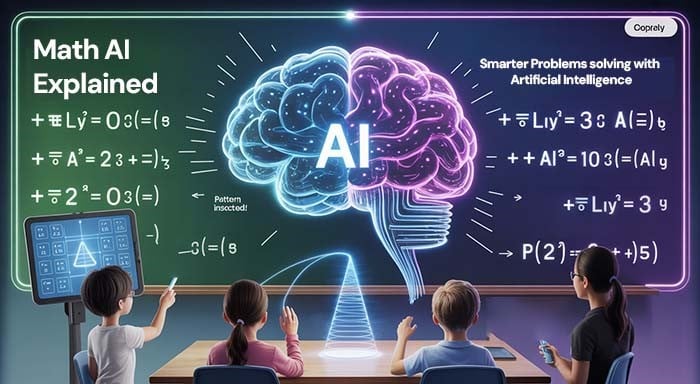In modern education, mathematics has continuously been driven by advanced technology integration, enhancing both computational thinking and digital literacy. The integration of artificial intelligence and traditional mathematics can transform how we solve complex problems. With the rapid growth of technology, there are a plethora of tools available that can provide answers, simplify difficult concepts, and resolve queries within seconds. However, Math AI is one such cutting-edge platform that uses AI algorithms to reshape the traditional problem-solving skills.
From geometry and algebra to calculus and statistics, this tool provides step-by-step solutions for all kinds of problems. With advanced algorithms like NLP and machine learning support, the tool enables users to upload the question in text, image and even voice format. Moreover, it provides AI assistance where students, teachers, and learners can ask their queries to AI characters in natural language.
This blog explores how math AI simplifies the learning process by streamlining everything from pattern recognition to logical reasoning in one cohesive platform. It also covers the tool’s features, benefits, and other similar platforms that drive the transformation of the mathematics world. First, understand what Math AI is.
Understand Math AI and its Evaluation
Mathematics has long been a complex subject that requires extensive problem-solving ability, like statistics, reasoning, calculus, and probability. The evolution of AI in mathematics has turned rule-based traditional systems to automated systems that can learn, interact, and process math problems. Today, modern AI-powered systems can grab everything from basic to advanced mathematics, making it more engaging and accessible.
Math AI is an innovative platform designed to understand, process, resolve, and interpret complex mathematics concepts. With AI capabilities, this platform can clarify expressions, suggest solutions, create problem sets, and explain problems in simple human-like ways. The goal of the platform is not only solving problems quickly but also changing our thinking with mathematical concepts.
Key Offerings of the Platform
For students, teachers, and professionals, this AI-driven platform provides unprecedented opportunities in the world of mathematics. The AI-driven platform is reinforcing practical solutions for complex concepts, aiming to develop cognitive skills and problem-solving. With the wide range of platforms available, how does it set itself apart from them? It offers a wide range of features and tools that mean the world of difference.
Step-by-Step Solution:
It is one of the standout features of this AI-powered platform. With advanced algorithm support like machine learning, it understands the problem effectively and breaks it down into smaller, manageable steps. This comprehensive approach helps students and educators better understand highly complex problems, such as algebraic expressions, derivatives, and integrals, effortlessly.
Personalized Learning:
With continuous learning support, the platform learns from their past experiences and conversations. Therefore, it helps provide a personalised solution according to the individual's specific learning style. If a student is stuck with a complex concept like quadratic equations, the AI interprets the question by incorporating real-life examples and scenarios.
Similar to the Blooket Bot, which turns intricate math problems into fun, engaging game-like experiences, this platform also optimizes the learning experience by making concepts easier to grasp.
Visualization Support:
One of the key features of math AI is its ability to make simple and engaging visual representations that make difficult concepts easy to understand. This uses real-world examples, storytelling, and step-by-step explanations to elaborate the concept easily. Moreover, it can generate detailed, high-quality output that enhances comprehension and makes the learning process easier.
Likewise, Getimg AI stands out as a strong alternative, allowing users to create visuals from simple text prompts, helping streamline abstract mathematics concepts. Beyond visualization capabilities, Math AI supports more advanced features and tools that make it a comprehensive tool for both students and teachers.
AI character Modeling:
The platform encourages students to create and simulate AI characters according to their specific requirements. These customised models (like friendly teacher, dedicated scientist, and mathematics expert) can answer questions based on your context. Users can ask their queries to these models, like defining variables, formulating equations, elaborating on the results, and proving theorems.
Unlike character AI and janitor AI platforms, where users can create and interact with AI personas that give answers based on analysing your behavior. It has also been a robust alternative to Math AI, turning the learning experience engaging and personalized.
By leveraging these features and characteristics, students not only solve intricate math problems. But it also understands the real-world applications of mathematics in different domains, like healthcare, engineering, aerospace, and more. This helps boost the analytical and problem-solving ability of students, educators, and math experts. Let’s go through some practical applications that highlight its use cases in different domains.
Real-World Applications
The significance of this AI-driven platform goes far beyond the academic settings, from finance to engineering and aerospace. Here is the detailed explanation:
- Engineering: From mechanical to electrical to computer engineering requires extensive knowledge of mathematics. These platforms save the time and effort of engineers by solving complex integrals, differential equations, linear algebra, and more. These mathematics concepts are essential for understanding and applying core engineering concepts in fluid dynamics, structural designs and electrical systems.
- Finance: This sophisticated platform plays a vital role in financial institutions by streamlining data analysis, predictions, and analysis of market movements. These systems interpret and explain vast amounts of financial data to detect patterns faster than human analysts.
- Research and Development: Professional research analysts and scientists leveraging AI-driven platforms to identify patterns and prove complex theorems. The AI can solve abstract symbolic equations and help developers design math-solving APIs for educational platforms.
- Educational: Most teachers and educators leverage the platform to create engaging sessions and quickly create grade assignments. Math AI’s exclusive features and capabilities can make the learning process simple and streamlined, helping students to understand highly complex concepts with easy explanations.
- Self-Learning: Students can also use this AI platform to solve their academic concepts, homework, and exam preparation in easy-to-understand ways. With personalized learning support, step-by-step problem-solving process, and AI-powered tools, it has become the go-to tool for students.
Common Challenges and Limitation
Despite their AI-driven capabilities, extensive feature sets, and supportive nature, the platform also raises some ethical concerns. These are described as follows:
- Educational Disruptions: While it is a valuable tool for breaking complex concepts into easy-to-understand parts, students may misuse this platform. It has been used for cheating in exams, copying homework, completing assignments, and bypassing the learning process.
- Over-Reliance: Most of the students depend heavily on solutions without understanding the concept and explanation. This over-reliance can hinder their entire mathematical understanding––problem solving, cognitive skills, and analytical thinking.
- Data Privacy: For developers, researchers, and financial analysts, keeping data secure is more crucial than ever. The most concerning challenge of Math AI is its lack of data security, which raises the risks of unauthorised access, data misuse, and sensitive data leaks.
Conclusion
Math AI has become a powerful companion that redefines how we approach mathematical problem solving, conceptual learning, and educational experience. Integrating artificial intelligence with traditional rule-based mathematics principles makes it more powerful and accessible for learners at all levels. Irrespective of whether you are a student struggling to solve a question or an analyst looking to enhance their research, it makes the process smarter, accessible, and interactive. Moreover, with Math AI and other platforms like Alaya AI, Cursor AI, and Botify AI, we can expect the future of mathematics to be de



